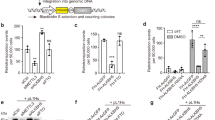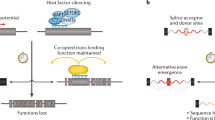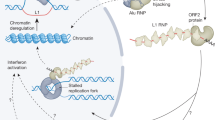Abstract
The ‘master’ human mobile element, the L1 retrotransposon, has come of age as a biological entity. Knowledge of how it retrotransposes in vivo, how its proteins act to retrotranspose other poly A elements and the extent of its role in shaping the human genome should emerge rapidly over the next few years. We review the impact of retrotransposons and how new insight is likely to lead to important practical applications for these intriguing mobile elements.
This is a preview of subscription content, access via your institution
Access options
Subscribe to this journal
Receive 12 print issues and online access
$209.00 per year
only $17.42 per issue
Buy this article
- Purchase on Springer Link
- Instant access to full article PDF
Prices may be subject to local taxes which are calculated during checkout
Similar content being viewed by others
References
Smit, A.F., Toth, G., Riggs, A.D. & Jurka, J., Ancestral, mammalian-wide subfamilies of LINE-1 repetitive sequences. J. Mol. Biol. 246, 401–417 (1995).
Smit, A.F. The origin of interspersed repeats in the human genome. Curr. Opin. Genet Dev. 6, 743–748 (1996).
Temin, H.M. Reverse transcription in the eukaryotic genome: retroviruses, pararetroviruses, retrotransposons, and retrotranscripts. Mol. Biol. Evol. 2, 455–468 (1985).
Rice, P., Craigie, R. & Davies, D.R. Retroviral integrases and their cousins. Curr. Opin. Struct. Biol. 6, 76–83 (1996).
Plasterk, R.H., Tc1/mariner transposon family. Curr. Top. Microbiol. Immunol. 204, 125–143 (1996).
Ivies, Z., Hackett, P.B., Plasterk, R.H. & Izsvák, Z., Reconstruction of Sleeping Beauty, a Tc1-like transposon from fish, and its transposition in human cells. Cell 91, 501–510 (1997).
Lower, R., Lower, J. & Kurth, R. The viruses in all of us: characteristics and biological significance of human endogenous retrovirus sequences. Proc. Natl. Acad. Sci. USA 93, 5177–5184 (1996).
Korenberg, J.R. & Rykowski, M.C. Human genome organization: Alu, lines, and the molecular structure of metaphase chromosome bands. Cell 53, 391–400 (1988).
Fanning, T.G. & Singer, M.F. LINE-1: a mammalian transposable element. Biochim. Biophys. Acta 910, 203–212 (1987).
Kazazian, H.H., Jr. et al. Haemophilia A resulting from de novo insertion of L1 sequences represents a novel mechanism for mutation in man. Nature 332, 164–166 (1988).
Woods-Samuels, P. et al. Characterization of a nondeleterious L1 insertion in an intron of the human factor VIII gene and further evidence of open reading frames in functional L1 elements. Genomics 4, 290–296 (1989).
Holmes, S.E., Dombrowski, B.A., Krebs, C.M., Boehm, C.D. & Kazazian, H.H., Jr. A new retrotransposable human L1 element from the LRE2 locus on chromosome 1q produces a chimaeric insertion. Nature Genet. 7, 143–148 (1994).
Narita, N. et al. Insertion of a 5′ truncated L1 element into the 3′ end of exon 44 of the dystrophin gene resulted in skipping of the exon during splicing in a case of Duchenne muscular dystrophy. J. Clin. Invest. 91, 1862–1867 (993).
Miki, Y. et al. Disruption of the APC gene by a retrotransposal insertion of L1 sequence in a colon cancer. Cancer Res. 52, 643–645 (1992).
Skowronski, J., Fanning, T.G. & Singer, M.F., Line-1 transcripts in human teratocarcinoma cells. Mol. Cell. Biol. 8, 1385–1397 (1988).
Vidaud, D. et al. Haemophilia B due to a de novo insertion of a human-specific Alu subfamily member within the coding region of the factor IX gene. Eur. J. Hum. Genet. 1, 30–36 (1993).
Wallace, M.R. et al. A de novo Alu insertion results in neurofibromatosis type 1. Nature 353, 864–866 (1991).
Miki, Y., Katagiri, T., Kasumi, F., Yoshimoto, T. & Nakamura, Y. Mutation analysis in the BRCA2 gene in primary breast cancers. Nature Genet. 13, 245–247 (1996).
Kingsmore, S.F. et al. Glycine receptor beta-subunit gene mutation in spastic mouse associated with LINE-1 element insertion. Nature Genet. 7, 136–141 (1994).
Mulhardt, C. et al. The spastic mouse: aberrant splicing of glycine receptor beta subunit mRNA caused by intronic insertion of L1 element. Neuron 13, 1003–1015 (1994).
Takahara, T. et al. Dysfunction of the Orleans reeler gene arising from exon skipping due to transposition of a full-length copy of an active L1 sequence into the skipped exon. Hum. Mol. Genet. 5, 989–993 (1996).
Kohrman, D.C., Harris, J.B. & Meisler, M.H. Mutation detection in the med and medJ alleles of the sodium channel Scn8a. Unusual splicing due to a minor class AT-AC intron. J. Biol. Chem. 271, 17576–17581 (1996).
Perou, C.M., Pryor, R.J., Naas, T.P. & Kaplan, J. The bg allele mutation is due to a LINE1 element retrotransposition. Genomics 42, 366–368 (1997).
Kuff, E.L. & Lueders, K.K. The intracisternal A-particle gene family: structure and functional aspects. Adv. Cancer Res. 51, 183–276 (1988).
Duhl, D.M., Vrieling, H., Miller, K.A., Wolff, G.L. & Barsh, G.S. Neomorphic agouti mutations in obese yellow mice. Nature Genet. 8, 59–65 (1994).
Michaud, E.J. et al. Differential expression of a new dominant agouti allele (Aiapy) is correlated with methylation state and is influenced by parental lineage. Genes Dev. 8, 1463–1472 (1994).
Argeson, A.C., Nelson, K.K. & Siracusa, L.D. Molecular basis of the pleiotropic phenotype of mice carrying the hypervariable yellow (Ahvy) mutation at the agouti locus. Genetics 142, 557–567 (1996).
Gardner, J.M. et al. The mouse pale ear (ep) mutation is the homologue of human Hermansky-Pudlak syndrome. Proc. Natl. Acad. Sci. USA 94, 9238–9243 (1997).
Hamilton, B.A. et al. The vibrator mutation causes neurodegeneration via reduced expression of PITP alpha: positional complementation cloning and extragenic suppression. Neuron 18, 711–722 (1997).
Kuster, J.E., Guarnieri, M.H., Ault, J.G., Flaherty, L. & Swiatek, P.J. IAP insertion in the murine LamB3 gene results in junctional epidermolysis bullosa. Mamm. Genome 8, 673–681 (1997).
Herrmann, B.C., Labeit, S., Poustka, A., King, T.R. & Lehrach, H. Cloning of the T gene required in mesoderm formation in the mouse. Nature 343, 617–622 (1990).
Steinmeyer, K. et al. Inactivation of muscle chloride channel by transposon insertion in myotonic mice. Nature 354, 304–308 (1991).
Adachi, M., Watanabe-Fukunaga, R. & Nagata, S. Aberrant transcription caused by the insertion of an early transposable element in an intron of the Fas antigen gene of Ipr mice. Proc. Natl. Acad. Sci. USA 90, 1756–1760 (1993).
Moon, B.C. & Friedman, J.M. The molecular basis of the obese mutation in ob2J mice. Genomics 42, 152–156 (1997).
Shiels, A. & Bassnett, S. Mutations in the founder of the MIP gene family underlie cataract development in the mouse. Nature Genet. 12, 212–215 (1996).
Loftus, S.K. et al. Murine model of Niemann-Pick C disease: mutation in a cholesterol homeostasis gene. Science 277, 232–235 (1997).
Dombroski, B.A., Mathias, S.L., Nanthakumar, E., Scott, A.F. & Kazazian, H. Jr., Isolation of an active human transposable element. Science 254, 1805–1808 (1991).
Moran, J.V. et al. High frequency retrotransposition in cultured mammalian cells. Cell 87, 917–927 (1996).
Sassaman, D.M. et al. Many human L1 elements are capable of retrotransposition. Nature Genet. 16, 37–43 (1997).
Naas, T.P. et al. An actively retrotransposing, novel subfamily of mouse L1 elements. EMBO J. 17, 590–597 (1998).
Mathias, S.L., Scott, A.F., Kazazian, H.H., Jr., Boeke, J.D. & Gabriel, A. Reverse transcriptase encoded by a human transposable element. Science 254, 1808–1810 (1991).
Luan, D.D., Korman, M.H., Jakubczak, J.L. & Eickbush, T.H. Reverse transcription of R2Bm RNA is primed by a nick at the chromosomal target site: a mechanism for non-LTR retrotransposition. Cell 72, 595–605 (1993).
Swergold, G.D., Identification, characterization, and cell specificity of a human LINE-1 promoter. Mol. Cell. Biol. 10, 6718–6729 (1990).
Branciforte, D. & Martin, S.L. Developmental and cell type specificity of LINE-1 expression in mouse testis: implications for transposition. Mol. Cell. Biol. 14, 2584–2592 (1994).
Bratthauer, G.L. & Fanning, T.G. Active LINE-1 retrotransposons in human testicular cancer. Oncogene 7, 507–510 (1992).
Yoder, J.A., Walsh, C.P. & Bestor, T.H. Cytosine methylation and the ecology of intragenomic parasites. Trends Genet. 13, 335–340 (1997).
Kurose, K., Hata, K., Hattori, M. & Sakaki, Y. RNA polymerase III dependence of the human L1 promoter and possible participation of the RNA polymerase II factor YY1 in the RNA polymerase III transcription system. Nucleic Acids Res. 23, 3704–3709 (1995).
Becker, K.G., Swergold, G.D., Ozato, K. & Thayer, R.E. Binding of the ubiquitous nuclear transcription factor YY1 to a cis regulatory sequence in the human LINE-1 transposable element. Hum. Mol. Genet. 2, 1697–1702 (1993).
Leibold, D.M. et al. Translation of LINE-1 DNA elements in vitro and in human cells. Proc. Natl. Acad. Sci. USA 87, 6990–6994 (1990).
Hohjoh, H. & Singer, M.F. Cytoplasmic ribonucleoprotein complexes containing human LINE-1 protein and RNA. EMBO J. 15, 630–639 (1996).
Hohjoh, H. & Singer, M.F. Sequence-specific single-strand RNA binding protein encoded by the human LINE-1 retrotransposon. EMBO J. 16, 6034–6043 (1997).
Martin, S.L. Ribonucleoprotein particles with LINE-1 RNA in mouse embryonal carcinoma cells. Mol. Cell. Biol. 11, 4804–4807 (1991).
Martin, S.L. Characterization of a LINE-1 cDNA that originated from RNA present in ribonucleoprotein particles: implications for the structure of an active mouse LINE-1. Gene 153, 261–266 (1995).
McMillan, J.P. & Singer, M.F. Translation of the human LINE-1 element, L1Hs. Proc. Natl. Acad. Sci. USA 90, 11533–11537 (1993).
Feng, Q., Moran, J.V., Kazazian, H.H. & Boeke, J.D. Human L1 retrotransposon encodes a conserved endonuclease required fo retrotransposition. Cell 87, 905–916 (1996).
Mol, C.D., Kuo, C.F., Thayer, M.M., Cunningham, R.P. & Tainer, J.A. Structure and function of the multifunctional DNA-repair enzyme exonuclease III. Nature 374, 381–386 (1995).
Gorman, M.A. et al. The crystal structure of the human DNA repair endonuclease HAP1 suggests the recognition of extra-helical deoxyribose at DNA abasic sites. EMBO J. 16, 6548–6558 (1997).
Xiong, Y. & Eickbush, T.H. Origin and evolution of retroelements based upon their reverse transcriptase sequences. EMBO J. 9, 3353–3362 (1990).
Nakamura, T.M. et al. Telomerase catalytic subunit homologs from fission yeast and human. Science 277, 955–959 (1997).
Eickbush, T.H. Telomerase and retrotransposons: which came first? Science 277, 911–912 (1997).
Dhellin, O., Maestre, J. & Heidmann, T. Functional difference between the human LINE retrotransposon and retroviral reverse transcriptases for in vivo mRNA reverse transcriptase. EMBO J. 16, 6590–6602 (1997).
Boeke, J.D. LINEs and Alus—the polyA connection. Nature Genet. 16, 6–7 (1997).
Chang, D.Y. & Maraia, R.J. A cellular protein binds 81 and Alu small cytoplasmic RNAs in vitro. J. Biol. Chem. 268, 6423–6428 (1993).
Chang, D.Y. et al. A human Alu RNA-binding protein whose expression is associated with accumulation of small cytoplasmic Alu RNA. Mol. Cell. Biol. 14, 3949–3959 (1994).
Chang, D.Y., Sasaki-Tozawa, N., Green, L.K. & Maraia, R.J. Atrinucleotide repeat-associated increase in the level of Alu RNA-binding protein occurred during the same period as the major Alu amplification that accompanied anthropoid evolution. Mol. Cell. Biol. 15, 2109–2116 (1995).
Jurka, J. Sequence patterns indicate an enzymatic involvement in integration of mammalian retroposons. Proc. Natl. Acad. Sci. U.S.A. 94, 1872–1877 (1997).
Shaikh, T.H., Roy, A.M., Kirn, J., Batzer, M.A. & Deininger, P.L. cDNAs derived from primary and small cytoplasmic Alu (scAlu) transcripts. J. Mol. Biol. 271, 222–234 (1997).
Luan, D.D. & Eickbush, T.H. RNA template requirements for target DNA-primed reverse transcription by the R2 retrotransposable element. Mol. Cell. Biol. 15, 3882–3891 (1995).
Author information
Authors and Affiliations
Corresponding author
Rights and permissions
About this article
Cite this article
Kazazian, H., Moran, J. The impact of L1 retrotransposons on the human genome. Nat Genet 19, 19–24 (1998). https://doi.org/10.1038/ng0598-19
Issue Date:
DOI: https://doi.org/10.1038/ng0598-19
This article is cited by
-
The composition dynamics of transposable elements in human blastocysts
Journal of Human Genetics (2023)
-
Pattern matching for high precision detection of LINE-1s in human genomes
BMC Bioinformatics (2022)
-
Global DNA methylation profile at LINE-1 repeats and promoter methylation of genes involved in DNA damage response and repair pathways in human peripheral blood mononuclear cells in response to γ-radiation
Molecular and Cellular Biochemistry (2022)
-
SINE jumping contributes to large-scale polymorphisms in the pig genomes
Mobile DNA (2021)
-
Silencing of LINE-1 retrotransposons is a selective dependency of myeloid leukemia
Nature Genetics (2021)



